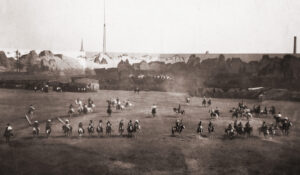The Texas Rangers: Vol. 1, Wearing the Cinco Peso 1821-1900
by Mike Cox, Forge (Tom Doherty Associates), New York, 2008, $25.95.
For many years, Walter Prescott Webb’s 1935 The Texas Rangers needed updating, but that is certainly no longer the case. Among the historians who have taken second and third looks at those famous fighting men are the late Frederick Wilkins, Charles M. Robinson III and Robert Utley. In fact, Utley’s second volume on the Rangers, Lone Star Lawmen: The Second Century of the Texas Rangers, came out just last year. Mike Cox, who jokingly tells people that he is a “writer-historian” while Utley is a “historian-writer,” shall also hurtle into the second century in his second volume. But first comes his first volume, which roughly covers the same time period as Utley’s Volume 1, Lone Star Justice. Even those who appreciate Utley’s study of the Rangers will enjoy the research and story-telling of Mike Cox, who began his research for the project in 1999.
Cox, who lives in Austin, was a newspaper reporter for many years and strives for impartiality in telling the Ranger tales, using the Rangers’ own words quite often as well as early newspaper accounts. He doesn’t shy away from the controversies, even though he spent 15 years as spokesman for the Texas Department of Public Safety, which includes the Texas Rangers. “The early rangers did not all wear white hats, no question,” he writes in his preface. “As I have tried to show in this book, bad men sometimes did saddle up for Texas….Other rangers helped create their legend, and still others lived up to that legend.” For the most part, Cox says, the Texas Rangers made Texas a safer place to live, and the end of the frontier did not mean the end of these internationally known lawmen.
The title of Cox’s book might cause bewilderment, but fortunately he provides “A Note on the Title” even before his preface. Legend has it that an early Ranger carved a star of five points in a coin and later in the 19th century some of the lawmen wore these star-in-the-wheel badges on their chest. The Rangers, though, did not get official badges until the 1930s and, as Cox says, “not until 1962 did Texas Rangers begin wearing badges crafted from genuine cinco peso pieces.” Anyway, the now famous badge not only found its way into the hearts of Texans but also onto the covers of Cox’s first volume and Utley’s second volume. In Part One of his first volume, Cox deals mostly with Rangers as Indian fighters (1821-73) and in Part Two as frontier peace officers (1874-99).
Originally published in the August 2008 issue of Wild West. To subscribe, click here.




